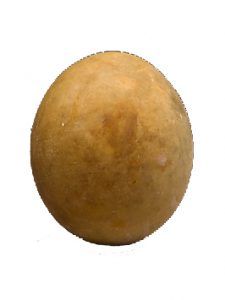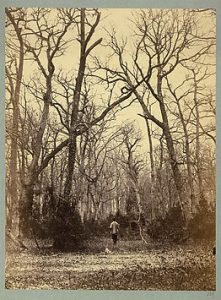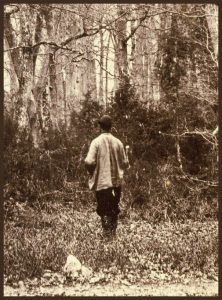by Timothy Don
Speak the word “discovery” and familiar images of explorers, scientists, ships, and treasure chests come to mind. To look into the visual record of “discovery” over the past 50,000 years, however, is to witness the concept expand, swell, and overwhelm the imagination. There is a wonder that arises in the wake of one’s research with the realization that the deeper and closer one looks, the wider, richer, and more capacious the topic at hand becomes. Consider the egg.

A simple egg. The familiarity of its shape is unnerving, even disarming. Hovering there, alone in space, it has the weight of a moon or a planet. A red planet. A symbol of discovery in its expansive, exploratory sense: to discover is to reach out into space, to land on the moon, to plan for Mars. But…this object is not Mars. It is an egg. It is an ostrich egg, more than 5,000 years old, from the predynastic period of Northern Upper Egypt, dug out of a tomb. Mars remains undiscovered. This is an artifact from an era now lost to us, uncovered by a forgotten Egyptologist from the 19th century. It belongs to the past. This is an actual discovery. And it is wonderful. It is pure potential. It has been discovered, but it remains uncracked. Full of mystery, this old egg from the past, it fills you with wonder. At that moment a gestalt switch gets thrown, and one realizes that discovery’s arrow points not only forward and outward to unexplored planets, but backward and inward to things lost, buried, and forgotten. To discover a thing is also to discover the past, and the act of discovery is about the recovery of the past just as much as it is about the probing of the future. And so a planet (symbol of the undiscovered future) becomes an artifact (material expression of the discovered past), and the artifact (the egg) becomes a mystery, a wonder, a promise. To be an egg is to promise discovery. Every egg, from this one (c. 3400bc) to the one you opened into a frying pan this morning, contains and shelters something utterly familiar and utterly unique, something waiting for you to find it. Every egg is a discovery.
There are certain artists who seem to have something to say about everything and whose work as a result appears regularly in the pages of the journal at which I serve as visual curator. Hieronymus Bosch is one. Caravaggio is another. Paul Klee and William Kentridge make the list. The genius of these artists (and many others) makes their work ever-contemporary, as immediate and compelling today as it was when they made it. The density of their work allows it to absorb the assault of time, so that its meaning can shift and apply itself to any period without diluting the purity of its original conception and execution.
Within each issue, however, there is always an image, or a handful of images, that capture, contain, and amplify the visual thrust and through-lines of the issue. Where “Discovery,” is concerned, the egg is one such. Here is another:

“Man in a Forest Landscape”: at first glance, a commonplace, almost banal image, redolent of those poems by Robert Frost one learned in grammar school (“Two roads diverged in a wood…” or “Whose woods these are, I think I know/ His house is in the village though…”), interesting only and purely as an artifact. But linger over the image for a moment, and see what it reveals.
This photograph is, like the egg, certainly an artifact from a bygone era, the early days of photography. It would be impossible to remake this image today, unless there is an app that can render digital photographs as albumen silver prints from glass negatives. And yet, anyone who has wandered in a forest landscape has found herself exactly as we find the subject of this photograph. We have all been there, where he is. We are each that man: he is as present today as he was 150 years ago at the moment the shutter blinked and captured him in the forest. History does not repeat itself. But it rhymes.
The subject of the photograph is situated between the past and the future. He is walking forward, into the forest of the future, but he is also walking away from the foreground of the past. He has turned his back on discoveries made; he seeks new discoveries in the forest ahead of him. But when we zoom in on the photograph and look at it closely, we see that he is not walking at all.  He has stopped. In fact, his forward movement has been arrested. The path or the opening into the forest that he has been following has closed up in front of him. Overhead and in a remote distance there is the promise of a new opening for him, and he can see it: a column of light, on the other side of all this undergrowth and bracken. Surely, some revelation is at hand. An annunciation awaits; a discovery is promised. But the way is barred; he will not gain it today. He has not lost the path; he is shut off from it.
He has stopped. In fact, his forward movement has been arrested. The path or the opening into the forest that he has been following has closed up in front of him. Overhead and in a remote distance there is the promise of a new opening for him, and he can see it: a column of light, on the other side of all this undergrowth and bracken. Surely, some revelation is at hand. An annunciation awaits; a discovery is promised. But the way is barred; he will not gain it today. He has not lost the path; he is shut off from it.
This is not, in other words, a simple photograph of a man taking a walk in the forest and finding things—himself, a nymph, Arcadia, the sublime, God—along the way. It is the portrait of a man on the threshold of a discovery, and it is his last, terrible discovery: that the major part of his life and the discoveries that life promised him are behind him. There is nothing new out there for him to find or to discover. The path forward is closed; all that’s left is for him to turn around, and back.
Every discovery bears along with it the sense of loss and closure that this photograph conveys. A dreadful realization, which can only come after the fact: To break a trail or to find a new world is also to shatter the possibility of ever discovering that world again. That realization is an effect of aging, and it is the hardest one to make, both for an individual and for a culture: discoveries are not infinite, and each one we make leaves one less to be made, until all our discoveries are behind us. It dawns on the individual at the time when she becomes aware of her own mortality; it dawned on the West right around the time this otherwise nondescript photograph was taken, as the West was gearing up for its own death in the first of the 20th Century’s world wars.
The realization, the discovery of discoveries’ limits, wounds deeply. Once it festers it invites the diseases of either denial or decadence. (It doesn’t ultimately matter: one leads into the other.) George Steiner, in an essay on education, history, and culture, expresses the problem acutely:
“Logically, inductively, there is absolutely no reason why a new Shakespeare or Michelangelo or Beethoven should not appear on the scene tomorrow morning; why the next Goethe should not be drafting his unprecedented Faust in the high rise apartment building next door. But how many of us, whatever our passions for modern, experimental art, truly believe in such epiphany? Resist, if you can, the seductions of facile pathos, of sunset in the Spenglerian vein; dismiss Valery’s warning as to the mortality of our civilization; involve yourself receptively with conceptual art, with electronic and aleatory music, with post-modern writing. Still the intuition gnaws: The humanities and arts in the West are virtuosities of twilight and recollection.”
It is not coincidental that the arrival of photography and the avant-garde in aesthetics occurred simultaneously, roughly at the end of the 19th century, with the dawning realization that the major part of aesthetic innovation in the West was behind us. Nor is it causal: the mechanism of the camera and the overwhelming power of the photograph did not singlehandedly strip innovation from the production of art, to be compensated for by the tyrannical rule of the avant-garde. Over the course of the 20th century, as we have urged art’s carthorse forward, we have saddled that horse with the avant-garde, and we have bridled it with photography. There is no point in lamenting or criticizing this move. It should be acknowledged, however: the triumphant and dominant art form of our age is photography because photography is the form most appropriate to the age in which we find ourselves. The argument might appear to be circular, but it is actually flat. In photography, the space and the distance between how we represent ourselves outwardly and how we understand ourselves inwardly is flattened. Photography is perfectly suited to our age because ours is the age of screens (you are reading this right now on a screen), an age in which increasingly we are losing our status as 3-dimensional people and becoming flat projections (photographs) of people. We desire nothing so much as to become the selfie that we are always taking. We no longer seek depth, dimensionality, texture. We want flat surfaces that project those qualities onto us. We want screens and photographs.
If photography speaks so powerfully to us, to the point at which it increasingly comes to speak for us, we should also remember that photography is an art form, and art, like winter, always has a twist in its tail. Art works upon us in ways of which we are often only dimly aware. Photography is the art form of our time, and while photography contributes to the flattening effect of contemporary culture, it also functions as a fixative, keeping us in position and gluing us together. Photography provides a flat record of dimensionality, a memory of what we once were and what we might have once become. To look at a photograph, whether it is “Man in a Forest Landsape” or a polaroid snapshot of one’s own childhood, is always to look into the past, into a memory. It is to perceive ghosts. This is why so many photographs have a spectral quality hovering about them, even our bright selfies. As we continue to flatten, to fade, to float on the surface of life, we become ghosts to ourselves. We become our own memories. Only photography (not painting, and not sculpture) can capture ghosts and memories. We inscribe ourselves in our photographs, we use them to project materiality onto ourselves, but we are becoming ghosts. We are becoming screen people. Pancake people. Flat people. Photography is both the record of that becoming and the memory of dimensions flattened.
If you have not yet reached the point in life at which the major part of your discoveries are behind you, one day you will. Like the man in the forest landscape, c. 1870, you will find that the promise of future discoveries is outstripped by the distance and effort it would take to make them. At that point, consider stopping, turning back, and rediscovering the past. The flatness of contemporary experience has probably rendered it opaque and hidden from you. But it is there. Dimensionality is hidden there, in the past. Stop. Turn. Consider the egg.
